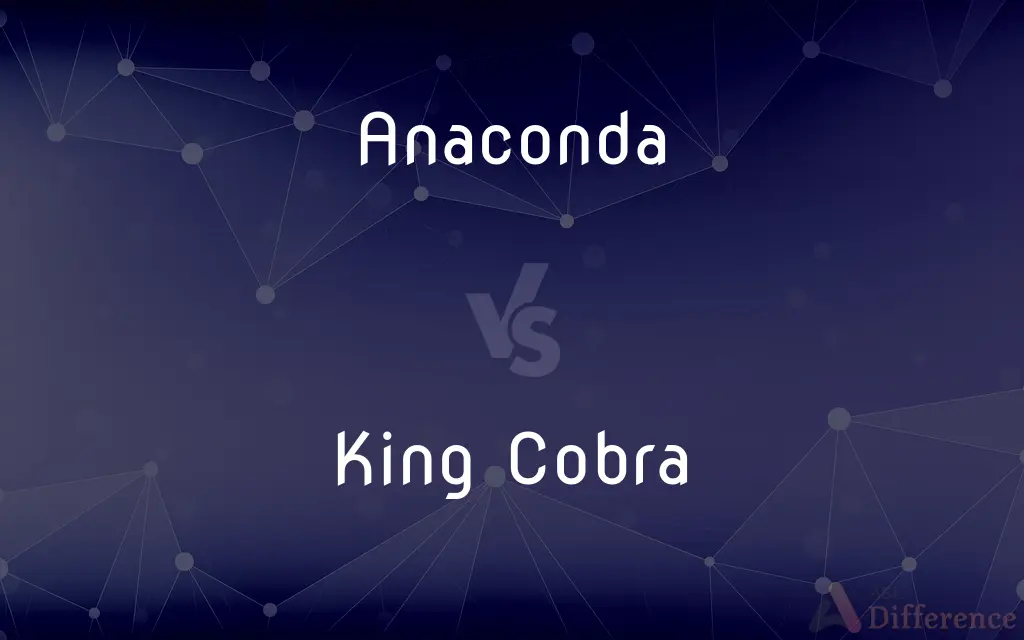Anaconda vs. King Cobra — What's the Difference?
Edited by Tayyaba Rehman — By Fiza Rafique — Published on December 11, 2023
Anacondas are large non-venomous constrictor snakes from South America, while King Cobras are venomous snakes from Asia known for their raised hood and potent venom.

Difference Between Anaconda and King Cobra
Table of Contents
ADVERTISEMENT
Key Differences
The Anaconda, primarily residing in South America, is one of the world's heaviest and longest snakes, recognized by many for its incredible girth and strength. The King Cobra, on the other hand, hails from the Asian continent and stands out due to its iconic hood and the title of the world's longest venomous snake.
Anacondas belong to the boa family and employ constriction as their method of subduing prey. When an Anaconda encounters its prey, it wraps around it and squeezes until the prey cannot breathe. Conversely, the King Cobra uses a different approach. With venom potent enough to kill an elephant, the King Cobra delivers a deadly bite to immobilize its prey or deter threats.
In terms of habitat, Anacondas are often found in wet, swampy areas, mainly in the Amazon rainforest's water bodies. They are excellent swimmers, often lurking just below the water's surface, waiting for prey. King Cobras, in contrast, are more versatile in habitat selection, ranging from dense forests to open fields in parts of Southeast Asia.
Anacondas are not venomous snakes. Their sheer strength and size allow them to overpower their prey. The King Cobra, meanwhile, relies heavily on its venom. A single bite can deliver a large quantity of neurotoxic venom, which can be lethal to humans and large animals if not treated immediately.
From a cultural perspective, both these snakes hold significant places in their respective regions. The Anaconda, due to its size, often finds itself in local myths and legends. The King Cobra, with its menacing hood and hiss, holds a revered and feared position in many Asian cultures, often associated with myths, medicines, and religious rituals.
ADVERTISEMENT
Comparison Chart
Continent of Origin
South America
Asia
Family and Method
Boa family, Constrictor
Elapidae family, Venomous
Primary Habitat
Wet, swampy areas (Amazon rainforest's water bodies)
Dense forests to open fields in Southeast Asia
Venomous or Not
Non-venomous
Venomous
Cultural Significance
Associated with local myths and legends
Associated with myths, medicines, and religious rituals in Asia
Compare with Definitions
Anaconda
Anacondas are powerful swimmers.
The Anaconda, mostly submerged, navigates the Amazon waters with grace and power.
King Cobra
King Cobra is the world's longest venomous snake.
Encountering a King Cobra in the wild is both awe-inspiring and dangerous due to its length and venom.
Anaconda
Anaconda is a heavy and long snake from South America.
The Anaconda, lurking in the Amazon waters, is an impressive sight due to its sheer size.
King Cobra
It possesses neurotoxic venom.
A bite from the King Cobra can be deadly, thanks to its potent neurotoxic venom.
Anaconda
It's a constrictor snake belonging to the boa family.
Unlike venomous snakes, the Anaconda kills its prey by constriction.
King Cobra
It's recognized by its raised hood.
When threatened, the King Cobra will raise its hood and hiss as a warning.
Anaconda
They are non-venomous snakes.
Despite its intimidating size, the Anaconda doesn't possess venom.
King Cobra
King Cobras have a significant cultural and medicinal role in Asia.
In certain Asian communities, the King Cobra is revered, and its venom is used in traditional medicines.
Anaconda
Anacondas are mainly found in wet, swampy areas.
While trekking through the Amazon rainforest, one might come across an Anaconda in marshy zones.
King Cobra
The snake is native to parts of Southeast Asia.
While hiking in the Asian rainforests, travelers might stumble upon the habitat of the King Cobra.
Anaconda
Any of several nonvenomous, semiaquatic snakes of the genus Eunectes of tropical South America that kill by coiling around their prey, especially E. murinus, which can attain a length of up to 9 meters (29.5 feet).
Anaconda
Any of various large nonvenomous snakes of the genus Eunectes, found mainly in northern South America. 19
Anaconda
(in particular) The green anaconda; Eunectes murinus.
Anaconda
A large penis.
Anaconda
(card games) A particular variety of stud poker.
Anaconda
A large South American snake of the Boa family (Eunectes murinus), which lives near rivers, and preys on birds and small mammals. The name is also applied to a similar large serpent (Python tigris) of Ceylon.
Anaconda
Large arboreal boa of tropical South America
Common Curiosities
Are King Cobra bites deadly?
Yes, King Cobra bites can be lethal due to their potent neurotoxic venom.
How does an Anaconda kill its prey?
Anacondas use constriction, wrapping around and squeezing their prey until it cannot breathe.
Can Anacondas swim?
Yes, Anacondas are excellent swimmers and often inhabit wet, swampy areas.
Is the King Cobra the longest snake in the world?
No, the King Cobra is the world's longest venomous snake, but not the longest overall.
Is the King Cobra protected in any regions?
Yes, in several of its native countries, the King Cobra is protected due to its declining numbers and habitat loss.
How long can an Anaconda get?
Some Anacondas can reach lengths of over 20 feet, making them among the world's longest snakes.
How does the King Cobra's venom affect its prey?
The venom of the King Cobra is neurotoxic, affecting the nervous system and causing paralysis.
Where can one typically find an Anaconda?
Anacondas are primarily found in South America, especially in the Amazon rainforest.
What's distinctive about the King Cobra's appearance?
The King Cobra is known for its raised hood, especially when threatened.
Are Anacondas venomous?
No, Anacondas are non-venomous constrictor snakes.
In which continents can you find the King Cobra in the wild?
King Cobras are native to parts of Southeast Asia.
What do Anacondas typically eat?
Anacondas prey on a variety of animals, including fish, birds, mammals, and even other reptiles.
Can Anacondas be found outside South America?
While native to South America, Anacondas might be found in zoos or as exotic pets elsewhere.
How do Anacondas and King Cobras differ in hunting strategies?
While Anacondas rely on constriction, King Cobras use their potent venom to subdue prey.
Are King Cobras aggressive towards humans?
While King Cobras usually avoid humans, they can be aggressive when cornered or threatened.
Share Your Discovery

Previous Comparison
Empirical Formula vs. Molecular Formula
Next Comparison
GMP vs. cGMPAuthor Spotlight
Written by
Fiza RafiqueFiza Rafique is a skilled content writer at AskDifference.com, where she meticulously refines and enhances written pieces. Drawing from her vast editorial expertise, Fiza ensures clarity, accuracy, and precision in every article. Passionate about language, she continually seeks to elevate the quality of content for readers worldwide.
Edited by
Tayyaba RehmanTayyaba Rehman is a distinguished writer, currently serving as a primary contributor to askdifference.com. As a researcher in semantics and etymology, Tayyaba's passion for the complexity of languages and their distinctions has found a perfect home on the platform. Tayyaba delves into the intricacies of language, distinguishing between commonly confused words and phrases, thereby providing clarity for readers worldwide.
















































